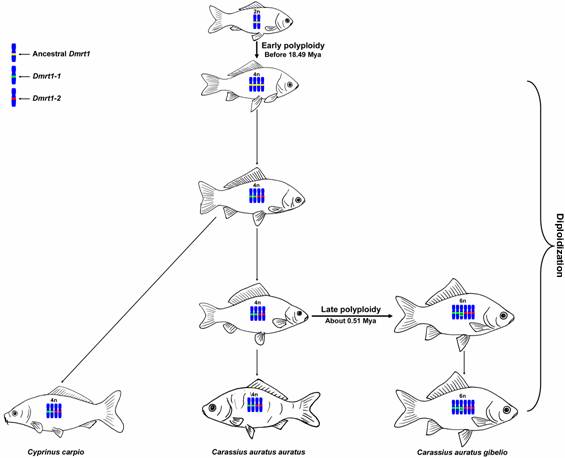
Newsroom
Two Rounds of Polyploidy Origins Revealed in Gibel Carp
A schematic diagram of two round polyploidy origins in gibel carp An early polyploidy might result in an common tetraploid ancestor ofCarassius auratus gibelio,Carassius auratus auratusandCyprinus carpiobefore18.49 million years ago (Mya),and an late polyploidy might occur from evolutionary branch ofCarassius auratusat around 0.51 Mya, whichlead to the occurrence of thehexaploid gibel carp. (Image / IHB)
Gibel carp (Carassius auratus gibelio), with more than 150 chromosomes, commonly has been recognized as a subspecies of Carasssius auratus with 100 chromosomes. Even though significant advances have been obtained in genetic basis and breeding application, some key evolutionary enigmas, such as the occurrence time and historical process of polyploidy, remain unknown in the polyploid gibel carp.

Recently, two rounds of polyploidy origins in gibel carp have been revealed through analysis of two divergent Dmrt1 genes, by the research team of Professor GUI Jian-Fang at Institute of Hydrobiology, Chinese Academy of Sciences (IHB). Firstly, the researchers identified two divergent Dmrt1 genes and respectively localized the two genes on three homologous chromosomes. Subsequently, the corresponding Dmrt1 genes were also characterized from the closely related species Carassius auratus auratus and Cyprinus carpio, and their two Dmrt1 genes were respectively localized on two homologous chromosomes.
Significantly, the evolutionary relationship analyses among cDNA and genomic DNA sequences of these Dmrt1 genes revealed two rounds of polyploidy origins in the gibel carp: an early polyploidy might result in an common tetraploid ancestor of Carassius auratus gibelio, Carassius auratus auratus and Cyprinus carpio before 18.49 million years ago (Mya), and an late polyploidy might occur from evolutionary branch of Carassius auratus at around 0.51 Mya, which lead to the occurrence of the hexaploid gibel carp. Therefore, this study provides clear genetic evidence for understanding occurrence time and historical process of polyploidy in polyploid vertebrates.
This study was performed by Li Xi-Yin et al., and the corresponding author was Professor GUI Jian-Fang. This work was supported by the National Key Basic Research Program of China and National Technology System for Conventional Freshwater Fish Industries. And the paper entitled “Evolutionary history of two divergent Dmrt1 genes reveals two rounds of polyploidy origins in gibel carp” has been published in the journal Molecular Phylogenetics and Evolution.